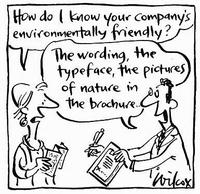Filed under: Business + Politics, Food + Health | Tags: greenwashing, McDonalds, McToxins, media literacy, Paul Hawken, public relations
I’m always amazed at the way in which my classes complement one another, build on one another, challenge one another and inform one another. This class always seems to be at the center of those relationships. I’ll give an example. In public relations class we have begun to study effective tactical planning and strategic media use. Naturally, we have looked at real-world examples of successful PR planning. On Monday we watched a short video clip from the mid-1990s? from ABC News. The clip was a short feature story on McDonald’s’ campaign to help poor farmers across the globe find niche goods to sell at market prices in order to prevent them from having to resort to environmentally unfriendly ways of making a living (i.e. cutting down rain forest trees for logging etc.). I’m glad McDonald’s had such a system but it should also be looked at skeptically. I was a little troubled with how this clip was presented in class as representative of the “green branding” of McDonald’s – as if stories placed strategically by effective public relations practitioners make McDonald’s green. In this sense, the perception of social responsibility, the public relations facade, is more important than actually being deeply committed to environmental stewardship. McDonald’s has certainly done some good things, but rarely on their own. It took, for example, a vigilant activist initiative, the so-called McToxins campaign, to get McDonald’s to finally stop using styrofoam packaging. McDonald’s public relations representatives even claimed at one point that styrofoam was good for the environment because it helped aerate the soil in landfills.
My public relations class is committed to the philosophy of “values-driven” public relations (it’s even the name of our textbook), yet this example seems to ignore “values-driven” business. You simply cannot have one without the other. For McDonald’s to be truly “values-driven” they would have to adopt sustainability as a chief corporate interest, as much a part of their national identity as the golden arches logo and the Big Mac. They have hardly reached that point, as Paul Hawken acknowledges in this article from the San Francisco Chronicle.
I’m not trying to rip my public relations class (it’s a really interesting, well-taught class), but it worries me a little bit that this example was used as effective “proactive” public relations. Honestly, “proactive” public relations begins with ethical business, creating a socially responsible culture that values human rights and social justice. Creating that type of corporate environment is in itself good public relations. It’s not manufactured narrow-mindedly. It’s important, in my opinion, to study not just the mechanisms of PR but also learn public relations literacy so students can recognize the agenda’s that underlie the media messages they receive. Combining these two would ensure students are not just good at public relations but more informed and perceptive citizens. I’m trying to make myself more questioning and more aware of where exactly the news I read and see is generated. It’s hard and I’m not very good at it.
So how can we avoid being duped by greenwashing? Improving media literacy? Is calling greenwashing manipulative an overstatement? Is the McDonald’s example truly good PR and I am way off?
-Vince
